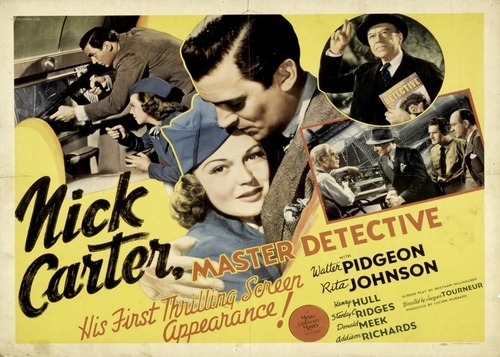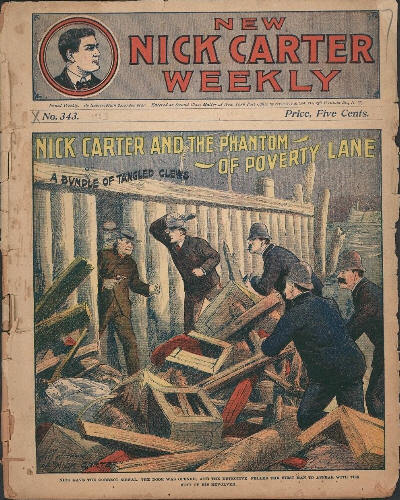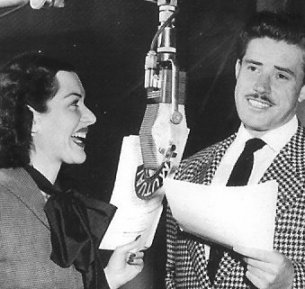"The most famous of all manhunters..." - a podcast by Mean Streets Podcasts
from 2017-04-11T18:00
“Calling Nick Carter! Another case for Nick Carter, Master Detective. Yes, it’s another case for that most famous of all manhunters, the detective whose ability at solving crimes is unequaled in the history of detective fiction - Nick Carter, Master Detective!”

In 1886, readers were introduced to a brilliant detective, a master of both disguise and deduction, who tackled the cases that baffled the police. Think you know who it is? If you guessed Sherlock Holmes, you’re a year too early. Arthur Conan Doyle’s first Holmes adventure was published in 1887, one year after the debut of Nick Carter, a character who went from dime novels to pulp magazines, and then to film and later radio. Though not as well known today, Nick Carter enjoyed a long career as one of America’s most celebrated detectives.
Carter’s first adventure was “The Old Detective’s Pupil,” which appeared in the September 18, 1886 issue of Street & Smith’s New York Weekly. Street & Smith were one of the largest publishers of dime novels in the country; in fact, the plot of the first Nick Carter story was dreamed up by Ormond G. Smith, son of one of the magazine’s founders. Writer John Russell Coryell wrote the story and two more before he decided there was more money in writing romances. The character was turned over to writer Frederick Rensselaer Dey, who penned a Carter novel (25,000 words) each week for seventeen years. Carter became so popular that Street & Smith launched a separate magazine devoted to his exploits.
Nick Carter was a clean-cut, teetotaling, private detective. He had an encyclopedic knowledge of the world and possessed almost superhuman strength; he could “lift a horse with ease…while a heavy man is seated in the saddle." Nick had been groomed for the gumshoe game from birth by his father, a famous detective named "Old Sim” Carter. Based in a ritzy New York apartment, Nick’s cases would take him all around the world. And he was famous all over the world, too. In 1908, the first of three Nick Carter film serials hit French movie screens, with sequels following in 1909 and 1912.

By 1915, the solo Nick Carter magazine had folded, but the character continued to make appearances in Street & Smith’s Detective Story Magazine. Later, after the company found pulp novel success with the exploits of The Shadow and others, Nick Carter was back in his own pulp magazine. In 1939, Hollywood came calling (albeit several years after French film producers), and Walter Pidgeon starred as Nick in three movies from MGM.
When the character came to radio in 1943, it was in The Return of Nick Carter. Those early shows tipped their hat to the character’s pulp origins with subtitled adventures (for example, “Murder in the Crypt…or Nick Carter and the Jackal God”). Actor Lon Clark, a former opera singer, took the role of Nick and kept it until the series left the air in 1955. His 12 years as Nick Carter are bested only by Bennett Kilpatrick’s 13 years as Mr. Keen, Tracer of Lost Persons. On radio, Carter was presented in the clean-cut mold from the pulps. He had a fancy brownstone house with a crime lab and shooting range in the basement where he’d work out cases with his friends and colleagues Patsy Bowen and reporter “Scubby” Wilson. They’d be called in, sometimes relcutantly, by Sgt. Mathison (affectionately known as “Matty” to Nick) on tough crimes that left the NYPD stumped.

Clark was supported by Helen Choate (a former radio Lois Lane) and later Charlotte Manson as Patsy. Ed Latimer provided the thick Irish brogue for Matty for much of the series. Scripts came from Walter B. Gibson, who wrote the pulp novels and fleshed out the history of Carter’s Street & Smith stablemate, The Shadow. Other writers on the show were Edith Meiser, who contributed scripts for Sherlock Holmes, and sci-fi author Alfred Bester. Walter Gibson also worked on the series’ short-lived spin-off Chick Carter, Boy Detective (Chick was Nick’s adopted son who followed in the family business).
The show, later retitled Nick Carter, Master Detective, aired on the Mutual Network until September 25, 1955 - outlasting several of the better known gumshoes of the Golden Age of Radio. When the radio series ended, Carter didn’t hang up his badge and gun. He was resurrected in the 1960s as a James Bondian secret agent in over 200 Nick Carter - Killmaster novels. In 1972, Robert Conrad, late of The Wild Wild West, starred as Carter in a turn of the century mystery set in the Victorian Era that would have served as a pilot for a new series. Unfortunately, this didn’t get picked up, but Nick Carter is still kicking over a century after he first appeared in print. His mix of brains and derring-do, with a healthy dose of pulp heroics, are well worth rediscovering or enjoying for the first time.
Further episodes of Down These Mean Streets (Old Time Radio Detectives)
Further podcasts by Mean Streets Podcasts
Website of Mean Streets Podcasts